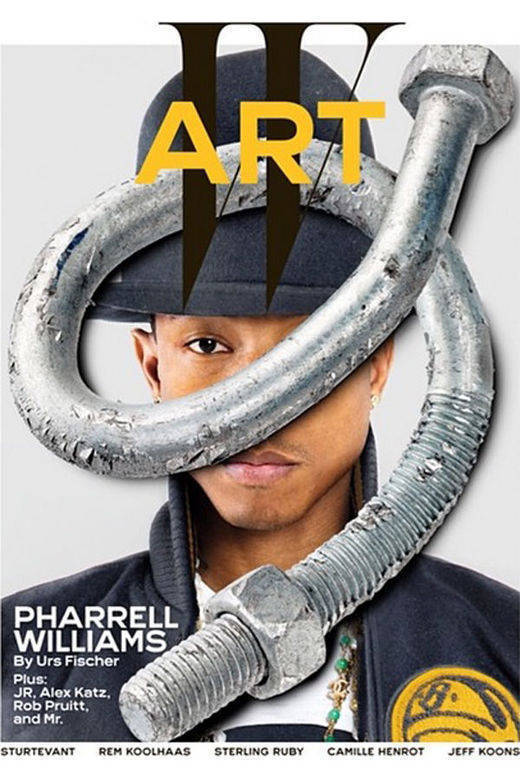
The Art of Being Pharrell.
By Lynn Hirschberg, Photo by Joshua White. The multi-hyphenate phenom opens up about living in the limelight. On January 26, at the Grammy Awards in Los Angeles, Pharrell Williams, who has been a musical sensation for most of his 41 years, had one of those rare nights that are life-changing. He won Four Grammys, including Producer of the Year, but the awards were not the only reason that the evening—maybe even the year—belonged to Pharrell.
Not only is he the cowriter of “Get Lucky,” by Daft Punk, and Robin Thicke’s “Blurred Lines”—songs that have madly addictive hooks that circle round and round in your head without end—but he also has unique personal flair that pops on TV and across the Internet. Williams, who has the ageless, slightly mysterious look of an Egyptian cat, with slanted almond-shaped eyes and sculpted features, seemed to know that his serious beauty needed a dollop of fun.
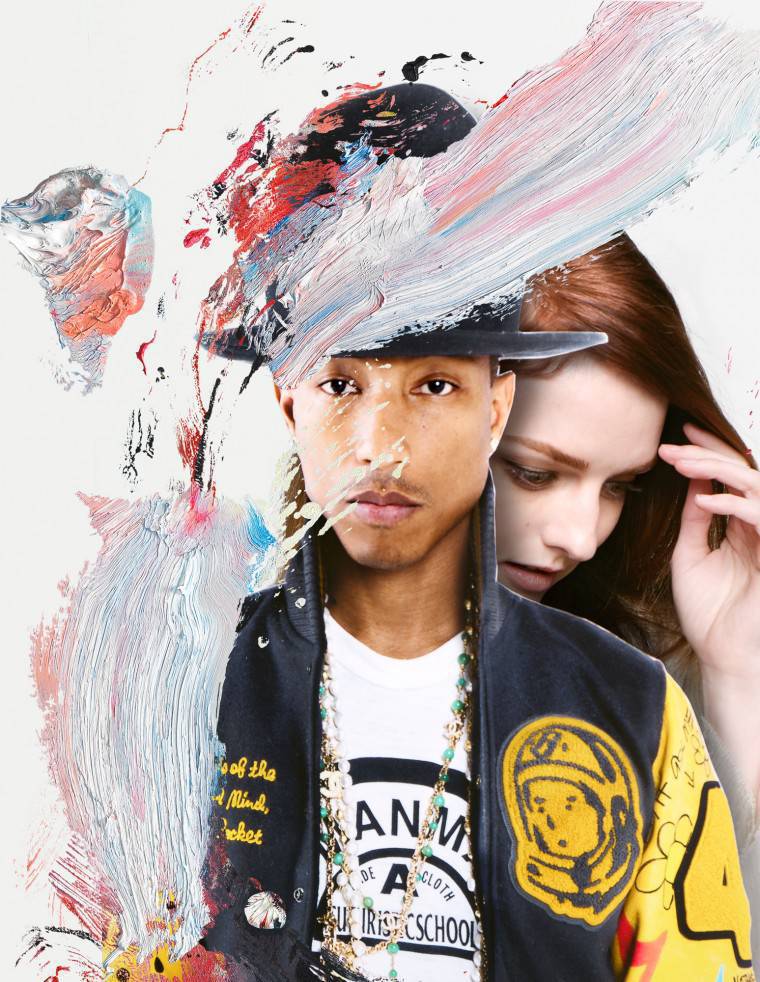
At the Grammys he was dressed in jeans, a red leather Adidas Firebird jacket tailored to hug his narrow frame, and, as always, a custom-made tangle of necklaces—costume Chanel chains that he had recast in gold with jade and large freshwater pearls in place of the fake gems. On Williams’s head was the final quirk: a brown felt, artfully dented Dudley Do-Right hat, designed by Vivienne Westwood in 1982. It was stately, arresting, and a little goofy—a perfect crown for the Pharrell coronation. The hat, which instantly became synonymous with its wearer and has rarely left his head since that night, was something else too—a visual reminder of Williams’s philosophy of music, style, and life: Respect the past, but mix it up to create something both subtly familiar and new.
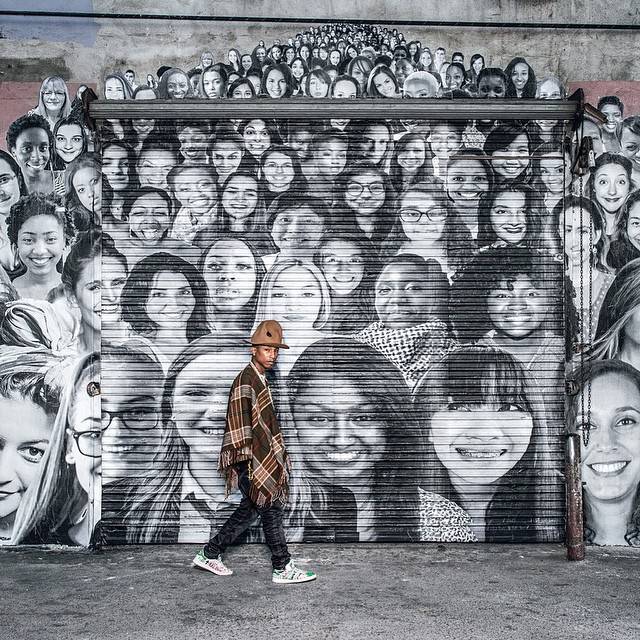
Since his youth in Virginia Beach, Virginia, where he was a prodigy on the drums, Williams has had great instincts and fearless curiosity. He has a knack for spotting talent (he singled out Justin Timberlake as a solo phenom when Timberlake was still committed to being in a boy band) and for picking up on the catchiness of a gospel chord progression (as heard in his infectious record-breaking No. 1 hit “Happy”). He is also a fashion savant, deftly able to fuse ’80s B-boy, old-school preppy, and avant-garde Japanese sensibilities in his clothing line, Billionaire Boys Club (BBC); and a major art collector—with tastes that range from the graffiti artist KAWS to Takashi Murakami.
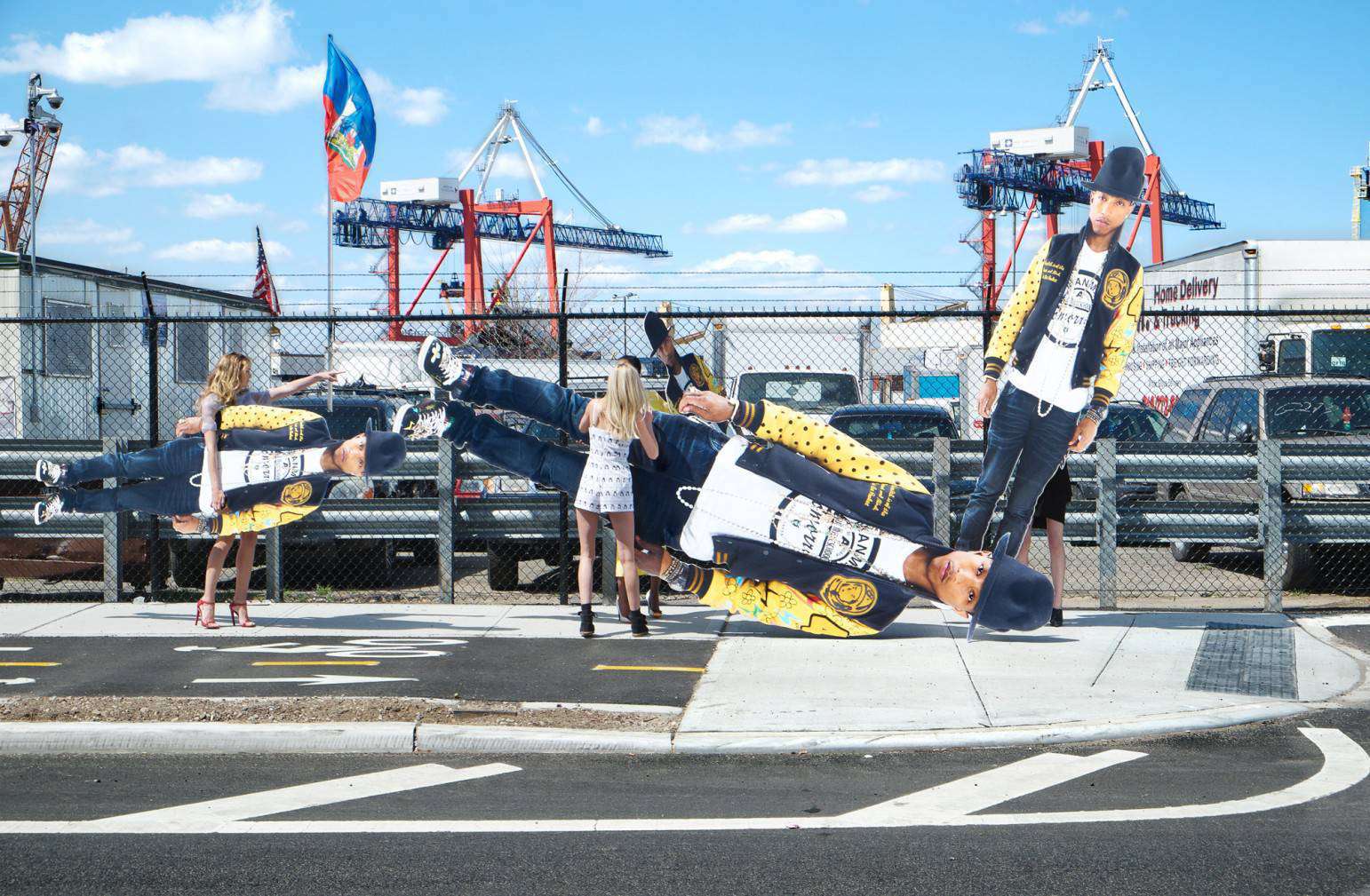
With Williams, the goal is always classic with a kick, a look or sound that you’ll subconsciously recall combined with something invented that you won’t be able to forget. “It’s a strange thing about the hat,” Williams told me three months after the Grammys, as he was waiting to rehearse “Happy” for an appearance on Saturday Night Live. It was 11:30 a.m. on a Thursday in early April, and Williams and his nearly all-female team (publicist, creative director, personal assistant, choreographer), along with his striking wife, the model Helen Lasichanh, were sitting in a tight cluster of chairs facing the stage at an NBC studio in Rockefeller Center.
*instagram.com/pharrell
*wmagazine.com
*bbcicecream.com
*vogue.de

Williams, who was wearing a gray hoodie with billionaire boys club written in script across the front, his usual chains, loose jeans, and a forest green version of the Westwood hat, had arrived late the night before from Los Angeles, where he attended the annual star-studded Museum of Contemporary Art gala. At the event, a zillionaire named Vivi Nevo had the audacity to wear the Westwood hat, too. “People didn’t like anyone else in Pharrell’s hat,” Lasichanh said, sounding somewhat amused. “People were upset. All night I kept hearing, ‘Why is someone wearing Pharrell’s hat?!’ ”
Pharrell’s hat was not purchased for the Grammys. In fact, the hat explosion is a parable about the power of the limelight. “I bought it five or six years ago,” Williams told me during the band’s sound check. “I went into the store World’s End in London with my friend Ronnie Newhouse to buy a pair of boots for my wife. While we were there, Ronnie [a creative director who understands the power and history of fashion like few others] told me that the hat was designed by Vivienne Westwood and was championed by her then husband, Malcolm McLaren, who managed the Sex Pistols. I bought two hats that day, and I wore one in a TV interview soon after. No one said anything about the hat. They didn’t notice.”
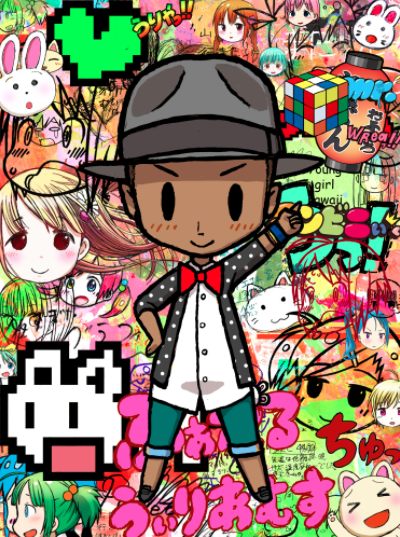
But that television appearance took place when Williams was not at the center of the world stage. Until 2013, he was hugely successful as a producer of songs like “Hollaback Girl,” by Gwen Stefani, and hits for artists as varied as Madonna, Snoop Dogg, and Britney Spears, but he was cult famous rather than mass, first-name-only famous. After early success with his adventurous band N*E*R*D, which he started with two middle school friends, Williams segued into being an interesting hybrid: a sleek, adaptable student of all types of commerce and culture. Although he released a solo album in 2006, it didn’t produce a hit single and quickly disappeared.
“By 2013, I had accepted my role as the…camouflage,” Williams explained. “I was the guy next to the guy, rather than the guy himself. All my formative years, I spent standing next to Jay [Z] or Justin [Timberlake] or all those kings. I’ve always learned from the masters, whether it’s in music or art or fashion. But in 2013, it was different: Suddenly, it was not about being the camo anymore.” And so, back to the metaphoric journey of the hat: On December 31, 2013, only a few weeks before the Grammys, Williams wore the hat for a live segment of the TV show New Year’s Rockin Eve. Although “Blurred Lines” and “Get Lucky” were the two songs of summer 2013, and even though Williams had appeared in the steamy video for “Blurred Lines,” which features lambs and topless models, Williams was still not a source of endless fascination—the hat, once again, went unnoticed.
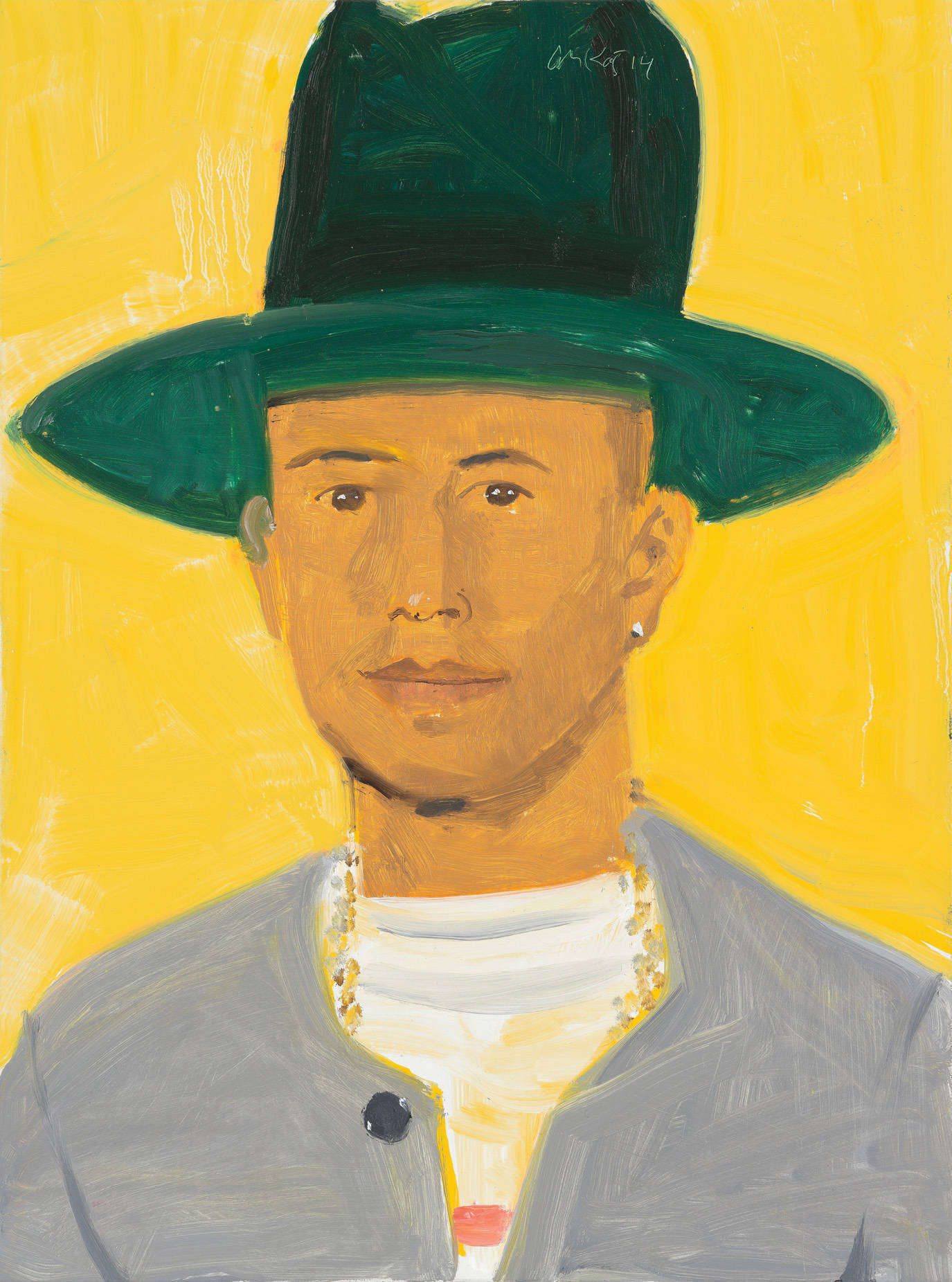
“After New Year’s, no one said anything online or anywhere else,” Williams recalled. “But at that point, I was used to wearing the hat. It felt right. Things were changing. And I decided to wear it again to the Grammys.” Suddenly, all in one night, everything clicked: The global soundtrack he had been creating for 2013 was finally appreciated in its entirety, and the hat became a symbol of his uniqueness. “I was genuinely shocked by Grammy night,” Williams said. “I had been happy running this career marathon. I didn’t expect any medals. I was particularly amazed when I went backstage after winning the first Grammy and one of my managers told me that my hat now had its own Twitter account. During the show, a fan started tweeting as my hat.” And that was the beginning of Pharrell Madness.
In a similar vein as the hat, his song “Happy,” which would seem like a surefire winner, was not instantly appreciated. Williams wrote the tune for 2013’s Despicable Me 2, an animated movie about a miserable man named Gru. “Happy” was the 10th song Williams suggested to producer Chris Meledandri. “I was at zero,” Williams explained. “After nine different songs, recorded fully, they were like, ‘No, no, no, no.’ So I went back and wrote ‘Happy.’ I didn’t have the melody, just the chorus. For 20 minutes after I finished, I was jumping around the room. I told Chris to listen to the song in his car, that if he didn’t like ‘Happy,’ I didn’t know what to give him.”
Meledandri put the song on repeat and was certain Pharrell had a hit, but radio wasn’t interested. The movie was huge at the box office, but no one was playing the song. Months later, Williams realized that “Happy” needed a visual beyond Gru. Williams, his team, and the directors who call themselves We Are From L.A. conceived “24 Hours of Happy.” In the world’s first round-the-clock music video, which went viral almost immediately, a cast of hundreds, most of them unknown Angelenos, dance to the song over and over again. Williams appears at the top of every hour to kick off the next burst of “Happy” enthusiasts. While The New York Times called it “punishment-level glee,” the online “Happy” extravaganza is a perfect cynicism-defying amalgam of infectious pop and art for the people.
It also made the song a massive success. By the time Williams performed the Oscar-nominated number in early March at the Academy Awards (wearing the hat, of course), “Happy” was No. 1 in Billboard’s top 100, breaking all kinds of records for songs initially rejected by radio. “After ‘Happy’ took off, I saw that my insignia should be an equal sign,” Williams said. He stuck out his feet, which were shod in distressed white Stan Smith sneakers that he had customized with brightly colored oil-paint pens. Williams had drawn a green equal sign on the toe box of his left foot, which pointed to a yellow daisy on the right shoe. “I have a new clothing collaboration with Adidas,” he continued.
“And it’s called Adidas = Pharrell Williams. I know I can’t trademark the equal sign, and that’s fine with me because, you know what? It’s just…equal. The ‘Happy’ video is about equality; my music is about equality, and being associated with the idea of equal got me where I am now.” Williams’s mantra of equality is genuine, but it may be a reaction to the furor over the lyrics to “Blurred Lines,” which many critics felt objectify women. Lines like “You’re an animal” and the overtly sexual video caused an uproar, especially when Miley Cyrus twerked her way to infamy during a raunchy rendition of the song at the 2013 MTV Video Music Awards. Again, “Blurred Lines” had been slow to take off—it sat on the shelf for eight months until the video caused a frenzy. “ ‘Blurred Lines’ made women, especially, want to dance,” Williams told me.
“I realized that a lot of women didn’t know how to fit in to the rhythm of rap songs—they needed music to bend and curve a little bit. I was producing Robin Thicke, and he is a soulful white boy and I thought we could take some chances. That song was what happened.” Learning from his “Blurred Lines” experience, Williams is more mindful of his key constituency: women. His new solo album, G I R L, with its intentional letter spacing to underscore that idea of equality, is dedicated to the spirit of females everywhere. “I fully realize the power of women,” Williams said as he prepared to go onstage. “If women wanted to put up their hands and say, ‘No more children,’ they could stop the world. We have to acknowledge their power: There is no person on the planet who didn’t benefit from a woman saying yes twice—yes to make you and yes to have you. And every human being came through the golden doors of a woman’s body. I’m not against the male species, but let’s make things equal. Other than the hat, I’m getting to be known for putting my hands together in a prayer of thanks. My mood these days is grateful. I am so, so grateful.”
The next day, Williams was in his two-room suite at the Crosby Street Hotel in downtown Manhattan. Lasichanh was in the next room, and their son, Rocket, who is 5, was visiting a museum with Williams’s parents, who had come to town from Miami Beach to see their son perform on SNL and to celebrate his 41st birthday, which was on the same day. Williams, who was wearing the ubiquitous green hat, a gray button-down sweater, his necklaces, and a string of large freshwater pearls hanging from the front belt loops of his jeans (“Women have never left my side, so I don’t feel uncomfortable wearing pearls,” he confided), had just returned from being painted by Alex Katz, the 86-year-old artist who was interpreting him for W.
“He talked about art and music—in that order—while he sketched,” Williams explained as he sat down on the edge of the couch. “And I was thinking about music and art in that order. We understood each other in parallels.” I asked Williams what it was like to be the subject as opposed to the creator of a piece of art. “I like the idea of being a character in someone else’s story,” Williams replied. “It sounds odd, but I’ve always considered myself to be one of the characters in a Wes Anderson movie. For a while, I would dress like one of his people—I would wear Wallabees and tan suits. And, like Jason Schwartzman in Rushmore, in my head I thought I was responsible for all the culture in my school, in Virginia Beach. When Bill Murray takes off running for no reason in that film, that feeling is absolutely true to my life. I see myself in that run.”
For Williams, being in Virginia Beach—where he grew up with his mother (a teacher), his father (a handyman), and two younger brothers—was a lucky break: In the early ’90s, the producer Teddy Riley, who worked with artists like Janet Jackson and Britney Spears, set up his studio five minutes away from Williams’s high school. “Instead of Riley moving his base of operations to New York or D.C. or even Suffolk or Hampton or Newport News, he moved his studio to Virginia Beach,” Williams recalled. “It was kind of like telling me that Jesus, E.T., and Elvis are going to walk in at any moment! It was that incredible—just the biggest, luckiest thing that could have happened in my life.”
By the time he was 19, Williams and his high school friend Chad Hugo, who played saxophone, had formed the Neptunes. Soon they were working on hits like Nelly’s “Hot in Herre” and Jay Z’s “I Just Wanna Love U (Give It 2 Me).” In August 2003, when Williams was 30, the Neptunes were responsible for 43 percent of the songs on the radio. “From the start, I chased my curiosities,” Williams said modestly. “I had a vision then—I’d be like, ‘It should be like this! Or ‘We have to do it like that.’ When I was young, I thought I knew everything. Now, I’m not sure if I know anything.” In 2006, he released his solo album, In My Mind, which flatlined. “Everything was just too crazy then, and I lost my sense of purpose,” Williams said.
“I was that guy who’s getting up in a girl’s ear, her eyes, her curves, her booty, and sweat, sweat, sweat.” Williams smiled. “Everything was too much. I couldn’t concentrate. And when the record failed, I decided that being a solo artist was just not my path. And I was okay with that.” For years, he focused instead on the intersection of music and fashion. He designed sunglasses with an aviator shape and gold accents for Marc Jacobs, and he appeared in ads for Louis Vuitton sporting jewelry he had designed. Unlike his hat-based image today, which is upbeat and friendly, the Pharrell of the late aughts was sexy, disco snazzy, and cool.
And yet he was always inventing something. “I would get my jewelry made by Jacob the Jeweler,” Williams said, showing off his striking chains. “And Nigo, who started Bathing Ape [the hugely successful Japanese fashion line known as BAPE], would go into Jacob with pictures of me torn from magazines and say, ‘Make me the same thing as Pharrell in another color.’ Jacob told me this, and I loved BAPE, so I looked Nigo up when I went to Japan. Although he didn’t speak English, we became friends, and he encouraged me to start my own line, which became Billionaire Boys Club. I described to Nigo what I wanted the line to be, and he helped me make it happen.”
A mogul was born. In addition to BBC and the just announced Adidas partnership, Williams has developed a fragrance with Comme des Garçons; a line of jeans with Bionic Yarn, a company that turns recycled plastic bottles into premium fabrics; a shirt collaboration with Uniqlo; and a series of limited-edition T-shirts inspired by the song “Happy.” “Music will always be my first love,” Williams said. “But the one thing I’ve learned is that this life is a movie and I am a cocreator.” He paused. “It’s a big movie, and there’s a lot of creativity going on.” Williams unconsciously patted the hat. “As long as I play my part, it won’t be over for quite a while.”
